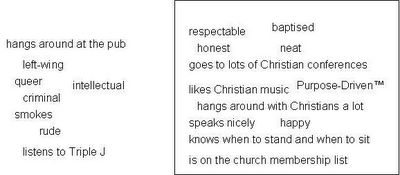Valuing every decision
Tonight I'm going down to Montrose, in outer-eastern Melbourne, for the Warrnambool Mission core leaders' weekend. Trav's asked me if I could talk about valuing every decision a person make that brings them closer to God. So here is some of the stuff I'll be talking about.
A farm with a fence
A lot of the time we look at God's Kingdom in terms of who's in and who's out. We work out whether someone's in or out by whether or not they display certain traits that we consider to be Christian. This is kind of like your generic farm, where the farmer keeps the animals together by putting a fence around them.
This point of view has a significant effect on the way to we do mission. It means that we focus almost entirely on getting people who aren't Christians to pray the sinner's prayer (which isn't actually in the Bible).
A farm with a well
Out in the desert, the farms are so big that there isn't much point in having fences. Instead, to keep the animals wandering off, the farmer digs a deep well. The animals will stay near the well, so that they don’t die of thirst.
We can also look at God's Kingdom like this. Rather than looking at each person as being inside or outside the boundaries, we could look at how close each person is to the centre (God), and whether they're moving closer or further away from him. If take this point of view, everyone is potentially part of God's Kingdom, and nobody is excluded.
Every decision is important
Instead of focusing on just getting a person to pray the sinner's prayer we should be concerned with each decision that brings a person closer to God.
The scale below shows some of the stages leading up to a person becoming a Christian. But the journey towards God doesn't stop with the person being reborn.
This scale is also helpful. It shows that a person needs to have more than just knowledge of the gospel to be converted. They also need to have a positive attitude about it.
The person in the bottom left section has little knowledge of the gospel, but still has a negative attitude toward it. The person in the bottom right section thinks the gospel is good, but doesn't know very much about it. The person in the top left section knows heaps about the gospel, and doesn't like it. The person in the top right corner is well-informed about the gospel, and thinks it's good.
So, for effective mission, we don't just need to get the story across, but to make it look attractive. If we do or say something that doesn't make the story much clearer, but makes it seem good, that is still evangelism.
If we can work out roughly where someone is on these scales, then maybe we can work out what is needed to get them to the next stage. We have to take into account what knowledge they already have of Christianity, and what attitudes they have towards it. It might not be appropriate at this stage to try and get them to commit to Christianity. First they need to make a heap of other decisions, and they'll have to keep making important decisions after they become a Christian.
Sources:
'Gray's the color of life', Gospelcom
The Shaping of Things to Come, Michael Frost and Alan Hirsch, pp 47-48
Some stuff Naomi Swindon talked to us about at core leaders' weekend last year



